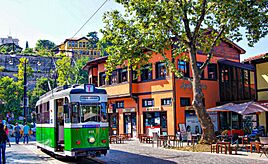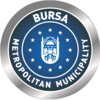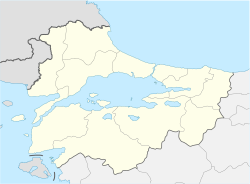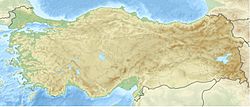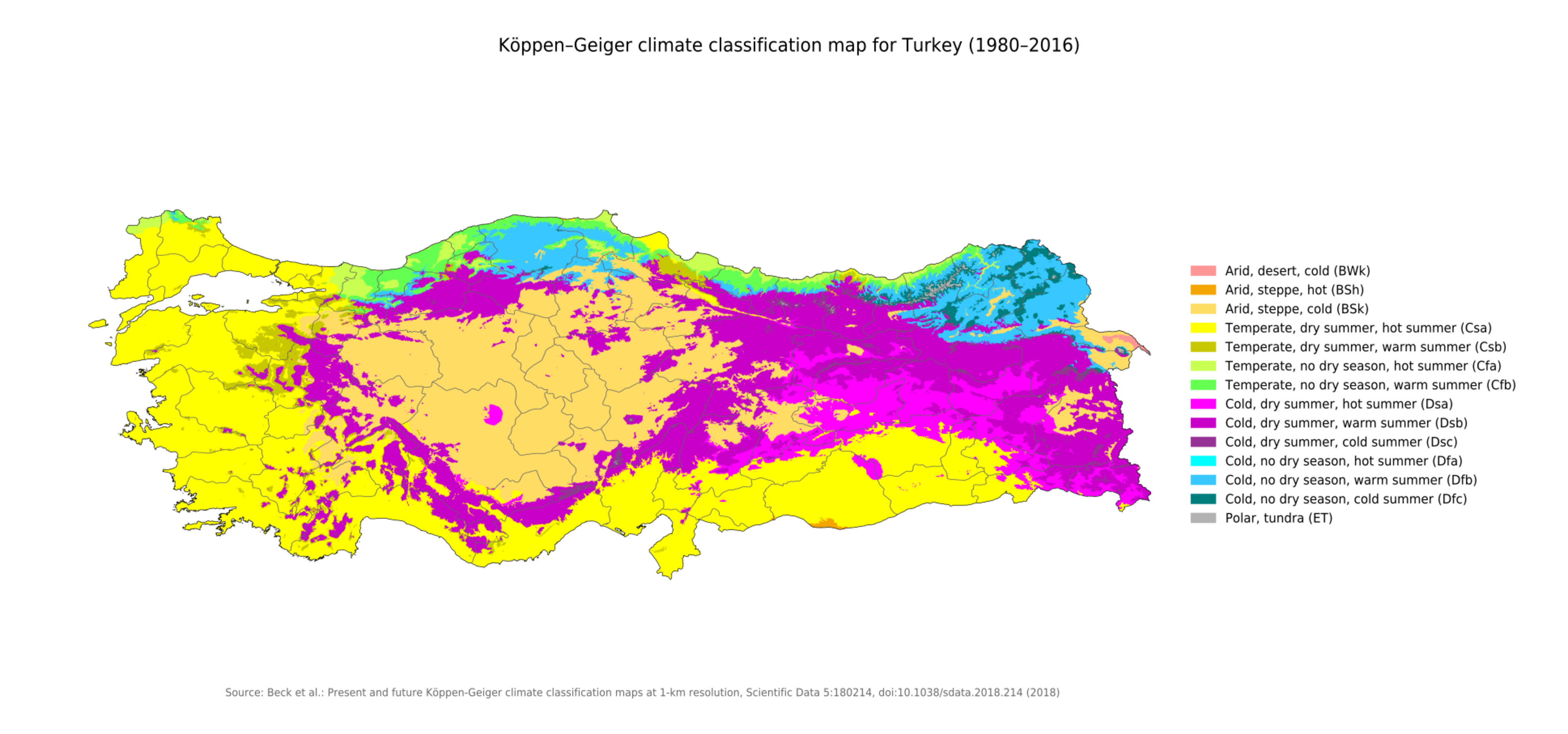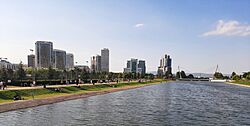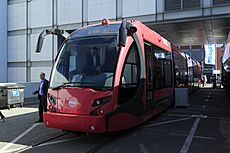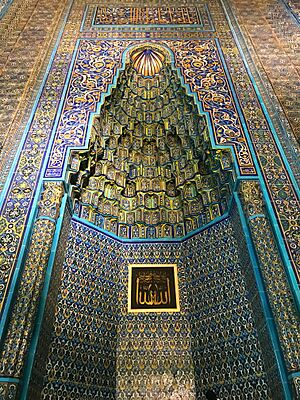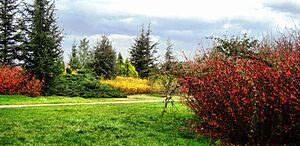Bursa facts for kids
Quick facts for kids
Bursa
|
||
|---|---|---|
|
City
|
||
|
Clockwise from top: Hüdavendigar Park; Green Mosque; Irgandı Bridge and Orhan Gazi Square; nostalgic tram on Cumhuriyet Avenue; Koza Han; and Bursa – Mt. Uludağ gondola lift
|
||
|
||
| Country | ||
| Region | Marmara | |
| Province | Bursa | |
| Area | ||
| • City | 10,422 km2 (4,024 sq mi) | |
| • Urban | 1,290 km2 (500 sq mi) | |
| • Metro | 17,806 km2 (6,875 sq mi) | |
| Elevation | 100 m (300 ft) | |
| Population
(2021 estimation)
|
||
| • City | 3,101,833 | |
| • Density | 297.624/km2 (770.84/sq mi) | |
| • Urban | 1,999,998 | |
| • Urban density | 1,550/km2 (4,015/sq mi) | |
| • Metro | 2,161,990 | |
| • Metro density | 121.419/km2 (314.474/sq mi) | |
| GDP | ||
| • City | ₺ 609 billion US$ 37 billion (2022) |
|
| • Per capita | ₺ 192,098 US$ 11,591 (2022) |
|
| Time zone | UTC+3 (TRT) | |
| Postal code |
16000
|
|
| Area code(s) | (+90) 224 | |
| Licence plate | 16 | |
| Website | www.bursa.bel.tr | |
| Official name: Bursa and Cumalıkızık: the Birth of the Ottoman Empire' | ||
| Type: | Cultural | |
| Criteria: | i, ii, iv, vi | |
| Designated: | 2014 (38th session) | |
| Reference #: | 1452 | |
| Region: | Europe | |
Bursa is a big city in northwestern Turkey. It's the main city of Bursa Province. People sometimes call it Prusa or Hüdavendigar, which means "God's Gift" in old Turkish.
Bursa is the fourth largest city in Turkey. It's also the second biggest in the Marmara Region. Many cars made in Turkey come from Bursa. In 2019, over 3 million people lived in the wider Bursa area.
Bursa was once the first major capital city of the Ottoman Empire. This was from 1335 to 1363. Today, it's often called Yeşil Bursa, meaning "Green Bursa". This name comes from its many parks, gardens, and the large forests around it.
The city has grown in an organized way. It sits next to a very fertile plain. You can find the tombs of early Ottoman sultans here. Many old buildings from the Ottoman period are also major landmarks. Bursa is also known for its warm thermal baths and old Ottoman houses. Mount Uludağ, a famous ski resort, stands tall over the city.
The well-known shadow play characters, Karagöz and Hacivat, are based on real people. They lived and died in Bursa in the 1300s.
Contents
Exploring Bursa's Past

The first known human settlement near Bursa was around 5200 BC. Later, the ancient Greek city of Cius was here. In 202 BC, King Philip V of Macedon gave it to Prusias I of Bithynia. King Prusias rebuilt the city with help from General Hannibal of Carthage. He renamed it Prusa.
After 128 years, the last King of Bithynia, Nicomedes IV of Bithynia, gave the kingdom to the Roman Empire in 74 BC. A Roman treasure, including silver items for women, was found near Bursa. It is now in the British Museum.
Under Byzantine rule, Bursa became a military city in 562 AD. Imperial guards were stationed there. By the mid-500s, Bursa was already famous for making silk textiles.
Bursa became the first major capital of the early Ottoman Empire in 1326. This happened after it was taken from the Byzantines. The city grew a lot during the 1300s. Hospitals, inns (caravanserais), and schools (madrasas) were built. The first official Ottoman money factory was also set up here.
In 1363, the Ottomans made Edirne their new capital. But Bursa stayed important for its spiritual and business life. Sultan Bayezid I built the Bayezid Külliyesi (a religious complex) in Bursa from 1390 to 1395. He also built the Ulu Cami (Grand Mosque) from 1396 to 1400.
In 1402, Timur defeated Bayezid in a battle. Timur's grandson then attacked and burned Bursa. But Bursa remained a key center until 1453. That's when Mehmed II conquered Constantinople (now Istanbul).
During the Ottoman period, Bursa was a main source of royal silk products. The city imported raw silk from Iran and China. It made many silk items like robes (kaftans) and pillows for the Ottoman palaces. Bursa was also known for its many hammams (baths). These were built during the time of Suleiman the Magnificent.
In the late 1800s and early 1900s, Bursa saw many changes. People from different backgrounds moved there. After the Republic of Turkey was founded in 1923, Bursa became a major industrial city. Its economy grew, and so did its population. Bursa became the 4th most populated city in Turkey.
Many people from the Balkans moved to Bursa. This happened when the Ottoman Empire lost lands in Europe. More recently, in the 1940s to 1990s, many Bulgarian Turks came to Turkey. About a third of these refugees settled in Bursa. Later, from 1980 to 2000, many people from eastern Turkey moved to Bursa. This was because new factories were built.
Bursa's Location and Weather
Bursa covers about 1.41% of Turkey's land. This makes it the 27th largest city in Turkey by area. Bursa is on the northwestern slopes of Mount Uludağ. It sits by the Nilüfer River, in the southern Marmara Region.
Bursa is the capital city of Bursa Province. This province borders the Sea of Marmara and Yalova to the north. To the northeast are Kocaeli and Sakarya. Bilecik is to the east, and Kütahya and Balıkesir are to the south.
Bursa's Climate
Bursa has a Mediterranean climate. This means it has hot, dry summers. These summers last from June to September. Winters are cool and wet, with the most rainfall. Snow can fall and stay for a week or two.
| Climate data for Bursa (1991–2020, extremes 1928–2023) | |||||||||||||
|---|---|---|---|---|---|---|---|---|---|---|---|---|---|
| Month | Jan | Feb | Mar | Apr | May | Jun | Jul | Aug | Sep | Oct | Nov | Dec | Year |
| Record high °C (°F) | 25.2 (77.4) |
26.9 (80.4) |
32.5 (90.5) |
36.2 (97.2) |
37.0 (98.6) |
41.3 (106.3) |
43.8 (110.8) |
42.6 (108.7) |
40.3 (104.5) |
37.3 (99.1) |
32.1 (89.8) |
27.3 (81.1) |
43.8 (110.8) |
| Mean daily maximum °C (°F) | 9.8 (49.6) |
11.4 (52.5) |
14.6 (58.3) |
19.2 (66.6) |
24.4 (75.9) |
28.9 (84.0) |
31.5 (88.7) |
31.7 (89.1) |
27.6 (81.7) |
22.2 (72.0) |
16.6 (61.9) |
11.5 (52.7) |
20.8 (69.4) |
| Daily mean °C (°F) | 5.4 (41.7) |
6.5 (43.7) |
9.0 (48.2) |
13.0 (55.4) |
18.1 (64.6) |
22.6 (72.7) |
25.1 (77.2) |
25.2 (77.4) |
20.8 (69.4) |
15.9 (60.6) |
10.7 (51.3) |
7.0 (44.6) |
14.9 (58.8) |
| Mean daily minimum °C (°F) | 1.7 (35.1) |
2.4 (36.3) |
4.1 (39.4) |
7.4 (45.3) |
12.0 (53.6) |
16.2 (61.2) |
18.4 (65.1) |
18.7 (65.7) |
14.8 (58.6) |
10.8 (51.4) |
6.0 (42.8) |
3.3 (37.9) |
9.6 (49.3) |
| Record low °C (°F) | −20.5 (−4.9) |
−19.6 (−3.3) |
−10.5 (13.1) |
−4.2 (24.4) |
0.8 (33.4) |
4.0 (39.2) |
8.3 (46.9) |
7.6 (45.7) |
3.3 (37.9) |
−1.0 (30.2) |
−8.4 (16.9) |
−17.9 (−0.2) |
−20.5 (−4.9) |
| Average precipitation mm (inches) | 79.2 (3.12) |
78.2 (3.08) |
74.9 (2.95) |
68.6 (2.70) |
47.9 (1.89) |
42.8 (1.69) |
14.3 (0.56) |
17.5 (0.69) |
50.1 (1.97) |
84.4 (3.32) |
67.3 (2.65) |
93.9 (3.70) |
719.1 (28.31) |
| Average precipitation days | 14.87 | 13.60 | 13.40 | 11.43 | 9.63 | 7.30 | 3.33 | 3.60 | 6.77 | 10.67 | 10.93 | 14.53 | 119.8 |
| Average snowy days | 5.08 | 3.71 | 1.46 | 0.08 | 0 | 0 | 0 | 0 | 0 | 0.04 | 0.42 | 2.42 | 13.21 |
| Average relative humidity (%) | 75.3 | 72.8 | 70.7 | 69.3 | 67.1 | 63.1 | 59.6 | 61.7 | 67.3 | 74.6 | 75.5 | 75.7 | 69.4 |
| Mean monthly sunshine hours | 83.7 | 90.4 | 124.0 | 165.0 | 217.0 | 264.0 | 300.7 | 275.9 | 217.0 | 145.7 | 111.0 | 77.5 | 2,071.9 |
| Mean daily sunshine hours | 2.7 | 3.2 | 4.0 | 5.5 | 7.0 | 8.8 | 9.7 | 8.9 | 7.0 | 4.7 | 3.7 | 2.5 | 5.6 |
| Source 1: Turkish State Meteorological Service | |||||||||||||
| Source 2: NOAA (humidity), Meteomanz | |||||||||||||
Bursa's Economy and Industries
Bursa is the biggest place for making cars in Turkey. Factories for car brands like Fiat and Renault are here. Many companies that make car parts, like Bosch, also have factories in Bursa.
The city is also strong in textile (fabric) and food production. Big drink brands like Coca-Cola and Pepsi Cola have factories here. There are also many companies that make fresh and canned food.
Besides cars, Bursa makes a lot of dairy products and other processed foods. It also produces popular local drinks.
Trade and Tourism
Bursa was once famous as the biggest center for silk trade. This was during the time of the Byzantine Empire and later the Ottoman Empire. It was an important stop on the busy Silk Road. Today, Bursa is still a major center for textiles in Turkey. It has a large international textile and trade center.
Bursa was also known for its rich soil and farming. But this has become less common as the city has grown with many factories.
Tourism is also a big part of Bursa's economy. Mount Uludağ, right next to the city, has one of Turkey's most popular skiing resorts. Bursa's warm thermal baths have been used for healing since Roman times. Many hotels have these baths. Uludağ University also has a special center that uses thermal water for physical therapy.
Getting Around Bursa
Bursa has a metro system called Bursaray. It also has trams and a bus system for getting around the city. Taxis are also available.
Bursa's Yenişehir Airport is about 20 miles (32 km) from the city center. Many people from Bursa also use Istanbul's airports for international flights. This is because Istanbul is quite close to Bursa. There are many daily bus and ferry services between the two cities.

The Bursa Uludağ Gondola (Teleferik) is 8.8 km (5.5 mi) long. It connects Bursa to the ski resort areas on Mount Uludağ. These areas are 1870 meters (6135 ft) high.
Most people in Bursa spend about 62 minutes traveling on public transport on a weekday. About 12% of riders travel for more than 2 hours every day. People usually wait about 18 minutes for public transport. The average distance for one trip is 8.1 km (5 mi).
Learning and Sports in Bursa
Education in Bursa
Bursa has two public universities and one private university. Uludağ University was founded in 1975. It is the oldest university in the city. It has about 47,000 students, making it one of the largest in Turkey.
Bursa Technical University is the second public university. It started teaching in 2011–2012. A private university, Bursa Orhangazi University, opened in 2012. However, it was closed by the Turkish government in 2016.
Istanbul Commerce University also offers advanced study programs in Bursa.
Sports in Bursa
Bursa has a professional football (soccer) team called Bursaspor. They used to play in the Süper Lig (Super League), which is Turkey's top football league. In 2010, Bursaspor won the championship title. This made them only the second team from outside Istanbul to win the Süper Lig.
Bursaspor plays its home games at the Timsah Arena. This stadium can hold 45,000 fans. Its name means "Crocodile Arena," because the crocodile is the team's mascot.
The city also has a professional basketball team, Tofaş S.K.. They are one of the most successful teams in the Turkish Basketball League. They play their games at the Tofaş Nilüfer Spor Salonu.
Famous Places to See in Bursa
Ulu Cami (Grand Mosque)
The Ulu Cami is the biggest mosque in Bursa. It's a key example of early Ottoman architecture. It uses many design ideas from older Seljuk buildings.
Sultan Bayezid I ordered this mosque to be built. Architect Ali Neccar designed it from 1396 to 1400. It's a large, rectangular building with twenty domes. These domes are in four rows of five and are held up by 12 columns. People say the twenty domes were built instead of twenty separate mosques. This was a promise Sultan Bayezid I made after winning a battle in 1396. The mosque also has two tall towers called minarets.
Inside, there are 192 large writings on the walls. These were made by famous calligraphers of that time. There's also a fountain (şadırvan) where people can wash before prayer. The dome above the fountain has a skylight. This lets in soft light, making the large building feel peaceful.
The inside of the mosque is wide and not too bright. This design makes it feel calm and private. This is different from later Ottoman mosques. Those mosques, built after Istanbul was conquered in 1453, had huge central domes. They were designed to feel grand and powerful.
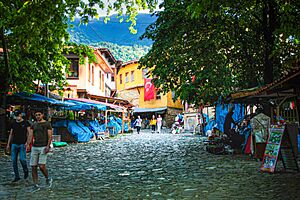
Other Interesting Places
Here are some other places to visit in and around Bursa:
Mosques and Külliye Complexes
- Bursa Grand Mosque and its complex (külliye)
- Yeşil Mosque and its complex
- Bayezid I Mosque and its complex
- Muradiye Mosque and its complex
- Emir Sultan Mosque and its complex
- Orhan Gazi Mosque and its complex
- Hüdavendigar Mosque and its complex
Bazaars and Caravanserais
- Yıldırım Bazaar (a covered market)
- Koza Han (a silk market)
- Pirinç Han
- İpek Han
Other Historic Sites
- Bursa Castle
- Irgandı Bridge
- İnkaya Sycamore, a huge 600-year-old tree
Museums
- Bursa Archaeological Museum
- Bursa Atatürk Museum
- Bursa City Museum
- Bursa Museum of Turkish and Islamic Art
- Tofaş Museum of Cars and Anatolian Carriages
Parks and Gardens
- Uludağ National Park
- Bursa Zoo and Botanical Garden
- Bursa Hüdavendigar Kent Park
Hot Springs and Thermal Baths
- Keramet hot spring
- Çekirge hot spring
- Oylat hot spring
- Çelik Palas thermal bath
Beaches
- Kumla beach
- Mudanya beach
- Manastir beach
Sister Cities of Bursa
Bursa has "sister city" relationships with many cities around the world. This means they share culture and ideas.
 Darmstadt, Germany (1971)
Darmstadt, Germany (1971) Sarajevo, Bosnia and Herzegovina (1972)
Sarajevo, Bosnia and Herzegovina (1972) Oulu, Finland (1978)
Oulu, Finland (1978) Kairouan, Tunisia (1987)
Kairouan, Tunisia (1987) Anshan, China (1991)
Anshan, China (1991) Bitola, North Macedonia (1996)
Bitola, North Macedonia (1996) Ceadîr-Lunga, Moldova (1997)
Ceadîr-Lunga, Moldova (1997) Kyzylorda, Kazakhstan (1997)
Kyzylorda, Kazakhstan (1997) Mascara, Algeria (1998)
Mascara, Algeria (1998) Kulmbach, Germany (1998)
Kulmbach, Germany (1998) Pleven, Bulgaria (1998)
Pleven, Bulgaria (1998) Plovdiv, Bulgaria (1998)
Plovdiv, Bulgaria (1998) Tirana, Albania (1998)
Tirana, Albania (1998) Košice, Slovakia (2000)
Košice, Slovakia (2000) Vinnytsia, Ukraine (2004)
Vinnytsia, Ukraine (2004) Szentendre, Hungary (2005)
Szentendre, Hungary (2005) Pristina, Kosovo (2010)
Pristina, Kosovo (2010) Bakhchysarai, Ukraine (2010)
Bakhchysarai, Ukraine (2010) Momchilgrad, Bulgaria (2010)
Momchilgrad, Bulgaria (2010) Mogilev, Belarus (2013)
Mogilev, Belarus (2013) Hebron, Palestine (2014)
Hebron, Palestine (2014) Herzliya, Israel (2014)
Herzliya, Israel (2014) Veliko Tărnovo, Bulgaria (2017)
Veliko Tărnovo, Bulgaria (2017) Galkayo, Somalia (2018)
Galkayo, Somalia (2018)
Images for kids
-
Statue of Atatürk in Bursa
-
Tomb of Osman Gazi
-
Atatürk delivering a speech in Bursa, 1924
See also
 In Spanish: Bursa para niños
In Spanish: Bursa para niños







